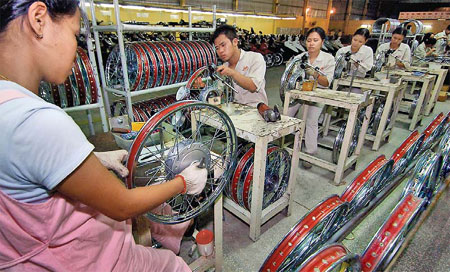At http://www.chinadaily.com.cn/video/2012-04/12/content_15035649.htm is a 30 minute interview (English sub titles) of Wei, telling about his 40 years (20 of them in Africa, almost every Arfician country) working to build Chinese African trade and social assistance. (For last three years, China has displaced the US as Africa´s main trading partner.)
Here are some quote from the associated article at http://usa.chinadaily.com.cn/weekly/2012-04/13/content_15036676.htm
“…Wei, China's former deputy minister of commerce and current secretary-general of the think tank China Center for International Economic Exchanges, is committed to promoting China-Africa trade cooperation. … "The most encouraging thing in my 40 years of service was to see Sino-Africa economic and trade cooperation develop by leaps and bounds." … the value of China-Africa trade had increased from just $1 billion (0.77 billion euros) a year in 1980 to $126.9 billion in 2010, and will reach $300 billion in three to five years, Wei predicts.
But China's relationship with Africa is about much more than trade:
"We have offered sincere economic assistance within our own capacity to African countries without any political conditions, and that aid is in line with the needs of Africa and its people. "We are helping African countries build capacity for self-development by training local people and sharing technologies with them, and encouraging Chinese enterprises to invest in Africa to increase employment, all of which local people welcome.
"African people feel that China's aid to them is sincere, and many of them look on us as 'Chinese brothers'."
Billy T comment:It is not just the economic war China is winning - It is winning the war for hearts and minds too. That is a little easier for China, as it too was exploited, not doing the US / European exploitation of the third world for 250+ years.
Here are some quote from the associated article at http://usa.chinadaily.com.cn/weekly/2012-04/13/content_15036676.htm
“…Wei, China's former deputy minister of commerce and current secretary-general of the think tank China Center for International Economic Exchanges, is committed to promoting China-Africa trade cooperation. … "The most encouraging thing in my 40 years of service was to see Sino-Africa economic and trade cooperation develop by leaps and bounds." … the value of China-Africa trade had increased from just $1 billion (0.77 billion euros) a year in 1980 to $126.9 billion in 2010, and will reach $300 billion in three to five years, Wei predicts.
But China's relationship with Africa is about much more than trade:
"We have offered sincere economic assistance within our own capacity to African countries without any political conditions, and that aid is in line with the needs of Africa and its people. "We are helping African countries build capacity for self-development by training local people and sharing technologies with them, and encouraging Chinese enterprises to invest in Africa to increase employment, all of which local people welcome.
"African people feel that China's aid to them is sincere, and many of them look on us as 'Chinese brothers'."
Billy T comment:It is not just the economic war China is winning - It is winning the war for hearts and minds too. That is a little easier for China, as it too was exploited, not doing the US / European exploitation of the third world for 250+ years.
Last edited by a moderator:





